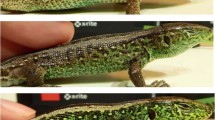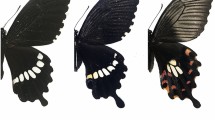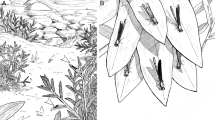Abstract
When male reproductive success depends on male–male competition and aggression, individuals which are at a competitive disadvantage sometimes adopt an entirely different constellation of reproductive behaviours. When such alternative reproductive patterns are practised opportunistically, as when a defeated territorial male adopts a parasitic role, or as part of a developmental sequence, as when younger males are satellites, they can be considered to be part of a single lifetime reproductive strategy. In contrast, when alternatives are available but individuals practise only a single reproductive option throughout their lifetime, the possibility of a genetic polymorphism can be considered. Such genetically mediated alternative reproductive strategies have been hypothesised1, but the ontogeny of supposed alternative reproductive strategies is seldom known2. This letter describes two reproductive patterns in bluegill sunfish (Lepomis macrochirus), a nesting male strategy and a female mimic strategy, and demonstrates that an individual male does not practise both reproductive strategies.
This is a preview of subscription content, access via your institution
Access options
Subscribe to this journal
Receive 51 print issues and online access
$199.00 per year
only $3.90 per issue
Buy this article
- Purchase on Springer Link
- Instant access to full article PDF
Prices may be subject to local taxes which are calculated during checkout
Similar content being viewed by others
References
Gadgil, M. Am. Nat. 106, 574–580 (1972).
Alcock, J. in Sexual Selection and Reproductive Competition (eds Blum, M. S. & Blum, N. A.) 381–402 (Academic, New York, 1979).
Constanz, G. D. Ecology 56, 966–973 (1975).
Emlen, S. T. Behav. Ecol. Sociobiol. 1, 283–313 (1976).
Lill, A. Z. Tierpsychol. 36, 515–530 (1974).
Thornhill, R. Science 205, 412–414 (1979).
Arnold, S. J. Z. Tierpsychol. 42, 247–300 (1976).
Morris, D. Behaviour 4, 233–261 (1952).
Barlow, G. W. Am. Midl Natur. 78, 215–234 (1967).
Taylor, J. N. thesis, Univ. Michigan (1979).
Wirtz, P. Z. Tierpsychol. 48, 142–174 (1978).
Henderson, D. L. & Chiszar, D. A. Anim. Behav. 25, 122–130 (1977).
Howard, J. W. Behav. Biol. 12, 559–565 (1974).
Huck, L. L. & Gunning, G. E. Tulane Stud. Zool. 14, 121–131 (1967).
Sparks, R. E. et al. J. Fish. Res. Bd Can. 29, 1356–1358 (1972).
Colgan, P. W. & Gross, M. R. Z. Tierpsychol. 43, 139–151 (1977).
Miller, H. C. Behaviour 22, 88–151 (1963).
Warner, R. R., Robertson, D. R. & Leigh, E. G., Jr. Science 190, 633–638 (1975).
Blackler, R. W. in Sea Fisheries Research (ed. Harden Jones, F. R.) 67–90 (Wiley, New York, 1974).
Pannella, G. Science 173, 1124–1127 (1971).
Taubert, B. D. & Coble, D. W. J. Fish Res. Bd Can. 34, 332–340 (1977).
Author information
Authors and Affiliations
Rights and permissions
About this article
Cite this article
Dominey, W. Female mimicry in male bluegill sunfish—a genetic polymorphism?. Nature 284, 546–548 (1980). https://doi.org/10.1038/284546a0
Received:
Accepted:
Issue Date:
DOI: https://doi.org/10.1038/284546a0
This article is cited by
-
Paternity share predicts sons’ fetal testosterone
Scientific Reports (2023)
-
Dimorphic male squid show differential gonadal and ejaculate expenditure
Hydrobiologia (2018)
-
Quantifying mating success of territorial males and sneakers in a bower-building cichlid fish
Scientific Reports (2017)
-
Social network analysis resolves temporal dynamics of male dominance relationships
Behavioral Ecology and Sociobiology (2014)
-
Status-dependent female mimicry in landlocked red-spotted masu salmon
Journal of Ethology (2006)
Comments
By submitting a comment you agree to abide by our Terms and Community Guidelines. If you find something abusive or that does not comply with our terms or guidelines please flag it as inappropriate.



